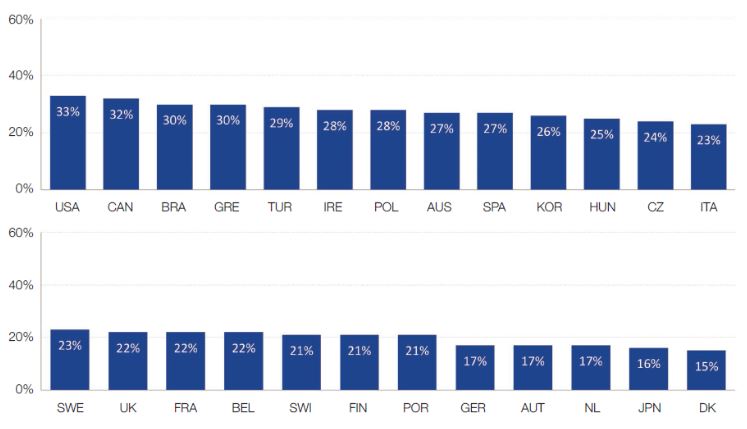While many publishers are investing heavily in online video, website users are more likely to watch short, emotional clips rather than news, a recent study by the Reuters Institute for the Study of Journalism found. In fact, 75 percent of respondents said they only occasionally (or never) watch news video online.
Out of the 26 countries included in the survey, the United States (at 33 percent) had the highest number people who said they watched online news video over the past week, followed by Canada (32 percent) and Brazil (30 percent).
Percentage of survey respondents who watch news video online
Survey respondents answered the following question: did you watch a news video online in the past week?
Survey respondents based in the U.S. (USA), Canada (CAN), Brazil (BRA), Greece (GRE), Turkey (TUR), Ireland (IRE), Poland (POL), Austria (AUS), Spain (SPA), Korea (KOR), Hungary (HUN), Czechoslovakia (CZ), Italy (ITA), Sweden (SWE), United Kingdom (UK), France (FRA), Belgium (BEL), Switzerland (SWI), Finland (FIN), Portugal (POR), Germany (GER), Australia (AUT), the Netherlands (NL), Japan (JPN) and Denmark (DK).
When asked why they didn't watch news online, 41 percent of respondents replied that they found reading quicker and more convenient. Another 35 percent said it was because they didn't like being forced to watch an advertisement before being able to watch the video — a practice known as "pre-roll."
This could arguably be interpreted as a warning sign for the global news industry, as many publishers have focused on news video advertisements as a way to fund cash-strapped newsrooms.
Newsroom leaders interviewed by the Reuters Institute said part of the reason they've become dependent on pre-roll is because advertisers haven't come up with a better way of reaching an audience. "What we know, right now, is that advertisers are happy with pre-rolls. It’s what they want," Alison Gow, the head of digital innovation at a local British newspaper, told researchers.
"The advertising business has not caught up yet with the changing nature of audience interaction," added Jason Mills at ITV News. "Where are the five-second pre-rolls?"
News sites versus social networks
Facebook's focus on video has also prompted some news organizations to invest heavily in video production. Currently, newsrooms are not earning much revenue from doing so — although there is hope that someday, they will be.
The Reuters Institute survey found that in some countries — particularly Brazil — the majority of respondents are primarily watching news videos on social platforms like Facebook. The trend hasn't yet spread to countries like the United Kingdom and Japan, however.
How big is your video team?
Even though it is not yet clear how newsrooms will get money from posting videos on Facebook and other platforms, that hasn't stopped some media organizations from investing heavily in their video teams, as seen in the chart below. Of the newsroom leaders interviewed, 79 percent said they plan to continue investing in video throughout 2016.
| News organization | Number of people working on online news video | Number of videos produced daily |
| The Telegraph | 7-8 producers and editors, plus a features/branding team | 30 news video + a special series |
| The Guardian | 30 | 20 |
| The Wall Street Journal | 40-50, but varies on the time of year | 30-40 |
| The Washington Post | 40 | 50 |
| Die Welt + N24 | 20 | 70 |
Despite this investment in video, newsrooms are still struggling to figure out how to best earn money from doing so. Besides the use of pre-roll ads — which the Reuters Institute survey found may actually be discouraging people from watching online news video — media companies are experimenting with sponsored content. BuzzFeed in particular has made this a core part of its strategy, producing videos for cat food companies and fast food chains.
However, as the report points out, this may not be possible for newsrooms with fewer resources. Additional investment in creating video content for advertisers may also be one reason why BuzzFeed did not meet its revenue targets last year, the report adds.
How many seconds of video count as a "view"?
Another problem for advertisers and media companies is measuring video ads' impact, as different social media platforms have different ways of counting a single "view." Facebook, for example, counts three seconds as a video view, compared to 30 seconds for YouTube.
The report concludes that the explosion in online news video isn't being driven so much by consumer demand as it is by publishers eager to supply videos, in hope that this will someday be a major source of funds for newsrooms. However, that currently isn't the case. More people are likely to continue watching more videos, as internet connections become faster and cheaper, and smartphone screens grow larger. Still, video is unlikely to replace text or solve the news industry's problem when it comes to making money, the report states.
Main image CC-licensed by Flickr via Roberto Ferrari.
All graphics created by or based on graphics created by the Reuters Institute and are used with permission.




